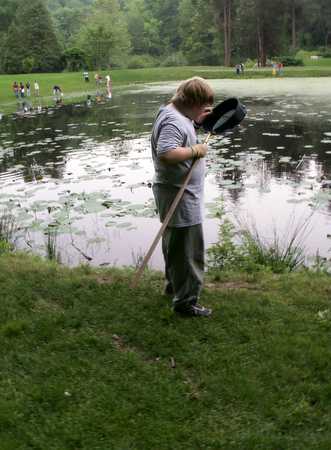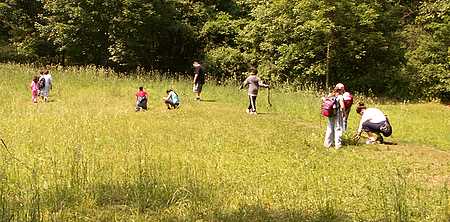Fall to Spring at ECOS
November 04, 2008
Ponds

A fourth grader carefully checks his net for pond creatures.
After arriving on the school bus at the cabin on Porter Lake in Forest Park, 4th grade students will begin their ECOS program by studying habitats. Through hands-on discovery activities, such as temporarily netting and capturing and then examining the creatures and plants in forest, field and pond environments, they learn about the different plants and animals that live in each and how they are interconnected. Students learn the basic survival needs of all living things: sun, food, air, water, shelter and space.
Posted by mpdoran at 01:03 PM
November 03, 2008
Forests
This Northern Screech Owl was found perching on a tree limb after dusk near the edge of Forest Park. They usually grow to no more than 8-10 inches, but like all owls, it is an able hunter. It sometimes eats other birds such as starlings, but its diet is widely varied, from chipmunks to flying insects to salamanders.
Fourth and fifth graders go into the forest to explore. They get down on the forest floor, turn over logs, collect specimens -- it's hands-on discovery. They learn that there's little to fear from the animals, plants and insects they encounter, and that mushrooms and molds might not be beautiful, but they play an indispensable part in the cycles of life in the forest.
A tour of the woods at Forest Park reveals a great diversity in plant and animal makeup. Slope and orientation to the sun, elevation, maturity, destructive pests, soil content, proximity to bodies of water, plus the effects of the surrounding communities and use of the woods by the people who visit the park are some of the factors that affect these habitats.
Posted by mpdoran at 01:35 AM
November 02, 2008
Fields

Fourth graders spread out to find snakes, toads, insects, spiders, plants and other field dwellers.
To find and capture animals in the field requires a keen eye and quick reflexes. Garter snakes, which have been caught in abundance this year, are shy creatures and fast movers. Anyone who has tried to catch butterflies knows that even with a net it can be a frustrating exercise. And many of the other insects and spiders are camouflaged and are skilled at hiding in the deep grass. But 4th graders are quick too.
The field helps demonstrate the interaction among habitats through some of its creatures. The students know that many of the creatures found in the field start out in the pond: the dragonfly, the damselfly, and the toad are the most prominent examples. They also know that the basic outline of the food chain is the same -- plants, which they also collect, are producers, and the animals are either consumers or decomposers. And though fungi, moss and lichen are usually associated with the forest, where they help break down organic and inorganic materials to produce soil, all three can also be found in the field or around its edges.
Posted by mpdoran at 12:29 AM
November 01, 2008
Winter
A 6th-grade class heads into the woods for a day of Winter Survival.
When they show up at Porter Lake for Winter Survival, the 6th grade students should be dressed warmly, because they are going to be outside for most of day one, which is for practice, and all of day two, during which they will put to use the survival skills they have
learned.
How to build a shelter to help protect them from the elements, how to build a fire to keep warm and heat their lunch over it, and how to break camp and leave their area the way they found it are the major lessons of day one.
Posted by mpdoran at 11:39 AM